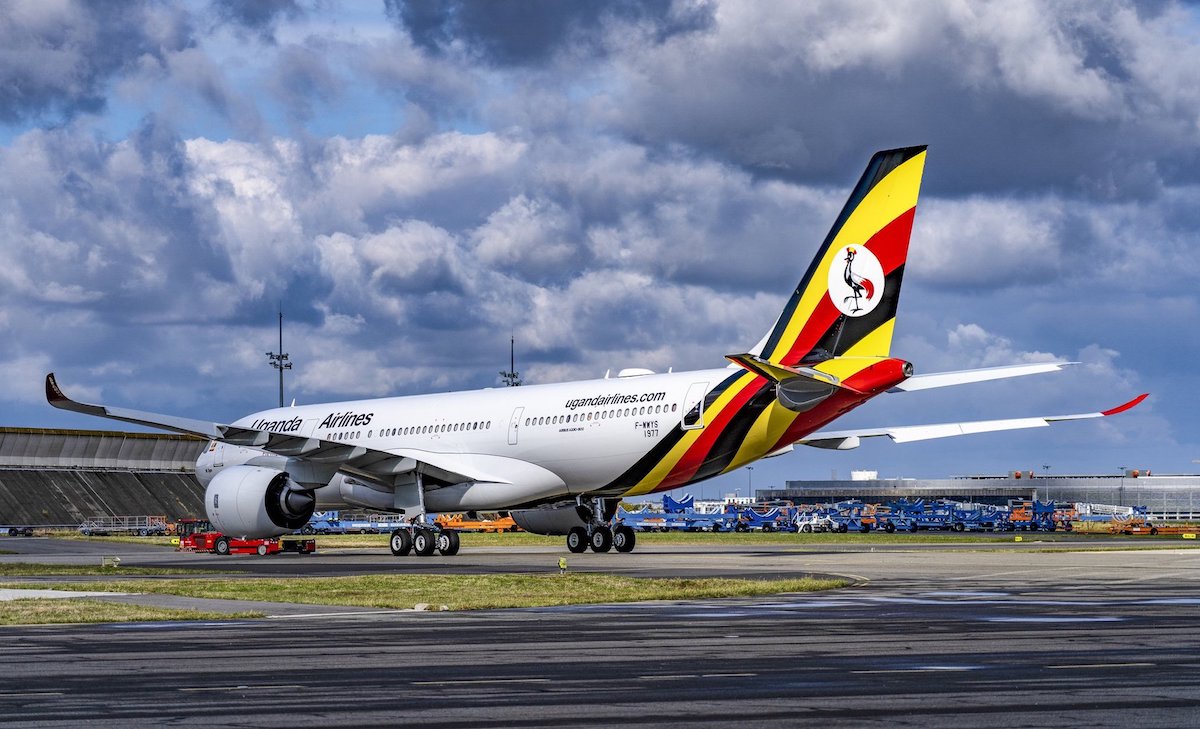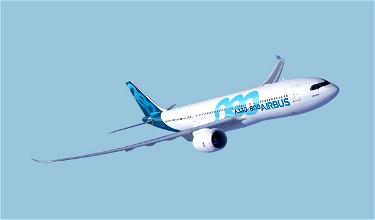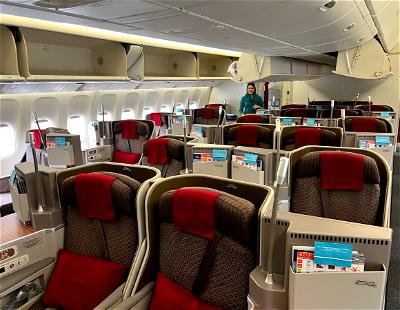It looks like Garuda Indonesia will be picking up four Airbus A330-800neos, which will make an interesting addition to the Indonesian flag carrier’s fleet.
In this post:
Garuda Indonesia’s A330-800neo order
As noted by Airways Magazine, Airbus’ latest orders and deliveries report discloses that Garuda Indonesia has placed an order for four A330-800neos. The airline has already ordered 12 A330-900neos, so altogether the airline will have a fleet of 16 A330neos.
 Garuda Indonesia already flies the A330-900neo
Garuda Indonesia already flies the A330-900neo
A couple of years back Garuda Indonesia signed a letter of intent for A330-800neos, but oddly we didn’t hear anything else from the airline about this. Airbus did list that four A330-800neos had been ordered by an “undisclosed customer,” but that only created confusion.
It would appear that the four A330-800neos bound for the undisclosed customer were in fact for Garuda Indonesia.
Why the A330-800neo is so rare
The A330neo is the latest plane in the A330 product line. It builds on the features of the popular A330 (including the A330-200 and A330-300), while leveraging technology developed for the A350.
There are two variants of the A330neo, but they’ve had totally different levels of popularity among airline customers:
- Only 15 A330-800neos have been ordered
- Meanwhile 316 A330-900neos have been ordered
What airlines ordered the A330-800neo?
- Eight have been ordered by Kuwait Airways
- Four have been ordered by Garuda Indonesia
- Two have been ordered by Uganda Airlines
- One has been ordered by Air Greenland
 Uganda Airlines was one of the first to take delivery of the A330-800neo
Uganda Airlines was one of the first to take delivery of the A330-800neo
Why have over 95% of A330neo orders been for the A330-900neo, with the A330-800neo having seen such little interest? It’s worth considering the two main differences between the planes:
- The A330-800neo has a capacity of 257, while the A330-900neo has a capacity of 287
- The A330-800neo has a range of 7,506nm, while the A330-900neo has a range of 6,550nm
In other words, the A330-900neo can seat an extra 30 passengers, while the A330-800neo can fly an additional 1,000nm. Which plane makes more sense depends on which of those metrics is more important for airlines.
Personally I get why the A330-900neo has been so much more popular than the A330-800neo:
- The operating costs of the A330-900neo are marginally higher than the A330-800neo; admittedly the larger plane may offer too much capacity for some markets, but even selling seats at a great discount airlines would likely come out ahead
- 6,500nm of range is already really significant, so unless airlines are trying to use these planes for ultra long haul flights, there are few situations where the A330-800neo’s additional range is needed
- For ultra long haul flights airlines have generally gone with either the 787 or A350, both of which still offer long range and reasonably low capacity (at least compared to previous generation aircraft)
Why the A330-800neo makes sense for Garuda Indonesia
Unlike with other airlines, I can actually see how the A330-800neo can make sense for Garuda Indonesia, given Indonesia’s geography. Here’s a map showing everything within range for the A330-800neo from Bali (just the dark shaded area isn’t within range):

Here’s a map showing everything within range for the A330-800neo from Jakarta:

Now, it’s worth noting that the above map is based on a range of 7,500nm, which ultimately isn’t quite realistic. That’s the maximum published range of the plane, but it doesn’t factor in headwinds, required fuel reserves, potential configurations, etc. In reality the range will likely be a bit less than that.
What does that open up for Garuda Indonesia?
- Amsterdam or London to Bali should be well within range for the A330-800neo, while it wouldn’t be for the A330-900neo
- There has long been talk of Garuda Indonesia wanting to fly nonstop from Bali to the US; I would think this is still really pushing it for the A330-800neo given that it’s right on the cusp of the range, but who knows
So yeah, I can see how Garuda Indonesia decided that this plane made sense, given that the extra range opens up a lot more destinations. Then again, that doesn’t address whether Garuda Indonesia should be operating any of these routes to begin with, given the extent to which the airline struggles with profitability.
Bottom line
It’s now official that Garuda Indonesia has placed an order for four A330-800neos. The airline is one of only four airlines to order this variant of the A330neo, and it has the second most of these planes on order.
I’ll be curious to see what Garuda Indonesia does with the A330-800neos. They could easily be used for nonstop flights from Bali to Europe, while I don’t think these planes could quite fly nonstop to the US.
Given Garuda Indonesia’s lack of A350 or 787 orders, this will likely be the carrier’s longest range plane once current 777s are retired.
What do you make of Garuda Indonesia’s A330-800neo order?





I think Garuda will fly to Los Angeles and San Francisco, considering there are many Indonesian diasporas, maybe 3x per week will be effective
please garuda improve ife system to make it responsive
With only 4 on order, if indeed used on ultra long haul, the options will be limited. LHR-DPS is 16 h or a 36 hour rotation including 2 h turnaround at both ends.
Considering provision for 1 unavailable plane (maintenance etc.), that leaves room for max ~14 ULR rotations per week. That's 2 flights per day. If the airline wants to offer some flexibility, they will serve each market at least 2x per week....
With only 4 on order, if indeed used on ultra long haul, the options will be limited. LHR-DPS is 16 h or a 36 hour rotation including 2 h turnaround at both ends.
Considering provision for 1 unavailable plane (maintenance etc.), that leaves room for max ~14 ULR rotations per week. That's 2 flights per day. If the airline wants to offer some flexibility, they will serve each market at least 2x per week. So they can open max 7 markets.
LAX, SFO with Delta make sense to absorb the US leisure and diaspora businesses, and for the european destinations, the best is to compete with the other alliances and offer competitive OD flights from big population centers that can fill up the plane like LHR/GTW, FRA/MUC while leveraging a Skyteam partnership through France or Netherlands for the other markets.
Add to that a constraint to serve both DPS and CGK, which gives flexibility to adjust to demand seasonality and the capacity is pretty much used up.
I think A330-800 is definitely suitable for Garuda due to better range performance, right sized capacity and operational capability which can be used both for long haul and short haul (domestic).
Majority of Indonesian secondary airports these days might have sufficient length to accept widebody aircraft such as the A330 families, but the limitation or challenges were in the ARFF (Rescue Firefighting) category which are mainly in the region of category 7 and 8.
...I think A330-800 is definitely suitable for Garuda due to better range performance, right sized capacity and operational capability which can be used both for long haul and short haul (domestic).
Majority of Indonesian secondary airports these days might have sufficient length to accept widebody aircraft such as the A330 families, but the limitation or challenges were in the ARFF (Rescue Firefighting) category which are mainly in the region of category 7 and 8.
Given the differences on ARFF Category (8 for A330-200/800 and 9 for A330-300/900) therefore, this aircraft should help the airline to develop its seats capacity, or else making their domestic flight schedules more effective and efficient by deploying widebody aircraft for busy domestic and regional routes and particularly during peak hours.
The Indonesian government now has officially established a tourism holding that aims to strengthen tourism and aviation sectors through collaboration in the long term.
It has identified the needs to overcome the existing issues, such as unbalanced traffic, non optimal international connectivity, as currently the domestic and international traffic are only centralised in CGK, DPS and SUB, and the fact that there were more than 23 million overflying passengers from Europe, North Asia to Australia in 2019 of which majority transiting in Singapore and Hong Kong ; with the recent airport development happening in Central and East Indonesia, this could be one potential that can be further developed in the future.
One of its long term aspirations is to develop connectivity beyond Jakarta and Bali, and following the massive airport development and expansion projects in Central and East Indonesia; the long term aspiration is making other potential secondary airports which are currently known to be underserved such as: Yogyakarta (YIA) as a new alternative for International transit hub. With the new YIA airport and larger capacity will help to promote this second most popular destination after Bali in Indonesia.
In addition, Indonesia should consider maximising its hub and spoke strategy for domestic (especially for non busy routes), which I think is also still relevant for Indonesia given that the country's geographical condition much likely unique and different than other countries; As a maritime country with 17,000 islands and that aviation is highly relied on by its people (not
land or sea transport) and reiterating the ultimate needs for secondary cities to be served with air connectivity for tourism, trade and logistics distribution.
Agree with the previous comment, that the US flights will be workable for Garuda, given the number of Indonesian diasporas in the West Coast, such as LAX and SFO. Let's accepting the fact that Indonesian diasporas are not as wide spread as others, compare to Vietnam, China or even the Philippines. Therefore, GA must focus on identifying this potential which currently reaped by its competitors.
I believe that VFR traffic will be the main driver of international flight passengers. Garuda must capture this opportunity. 1 or 2x weekly and the OD schedule should be equal between CGK and DPS.
I think with one technical stop either in DPS or HNL (should a technical stop is still required) is still OK, like when they did in 1990s with MD-11ER (and they were granted with transit rights or co-terminalisation rights, if I am not mistaken). Thus, for US flights I think no need for the airline to ask for fifth freedom rights from a third country airport, my prediction is that post COVID-19 it'll be more convenient for the airline to form bilateral agreements between 2 countries only.
US vacationers’ interest to visit Bali is high but the hassle of spending over 24 hours travel time with connection usually gets in the way.
A direct flight between Bali and major West Coast city/cities will cut down the travel time and making the route very attractive.
Garuda partners with Delta, so it will be and easy connection to fly Delta from anywhere in US to the hub city and hop on that...
US vacationers’ interest to visit Bali is high but the hassle of spending over 24 hours travel time with connection usually gets in the way.
A direct flight between Bali and major West Coast city/cities will cut down the travel time and making the route very attractive.
Garuda partners with Delta, so it will be and easy connection to fly Delta from anywhere in US to the hub city and hop on that GA nonstop flight to Bali without having to fly through ICN, NRT, HKG, TPE or SIN and shave off significant travel time.
There is also an Indonesian diaspora in West Coast especially around LAX and SFO that will be enough to keep the route going if they have 1-2 weekly flights.
I visited Indonesia a few months back and flew GA domestic, and with the great service they give on board I can’t wait to have them as an option for US to Bali route.
I dont think if garuda can sustain the U. S. flight. If they do it its just a financial disaster waiting to happen. Most southeast asian airlines avoided U. S. flight with exception to singapore airlines(business travellers) and philippine airlines(more than 6 millions filipino diaspora in U. S.)
Interestingly Indonesia is the only major Southeast Asian country to have zero A350s and 787s, because Garuda and Lion love the A330neo so much.
@Florian, exactly my point!! When CI (China Airlines) restarted direct LGW-TPE flights with onward connections to Auz and NZ they gained market share due to there lower price points and well regarded service compared to the mainland Chinese carriers. If GA can follow suit and offer FOC stopovers in DPS i.e no increase of fare for a stopover and offer economy fares in the £500ish range/ £430ish sale range they would do extremely well!
@airlineinsider91 that is an excellent point. As a youngster (20y ago) Garuda was an Aussie uni student’s cheapest option to Europe. Most high end travellers in Oz are QF FFs and will forever be beholden to the ‘roo (particularly if flying QF codeshare on Emirates metal!) but Garuda may get a big holiday/backpacker market when borders ease if the connections through DPS are good.
What's an airplane production line like? With only 15 airplanes of that type sold, wouldn't diverting manufacturing resources to other better selling aircraft be better wrt minimizing company expenses?
LAX would be marginal
But judging from your map, SEA or YVR seems possible and viable
Where are you getting the 7506-mile range figure? Wikipedia and Airbus' website both state a range of 8150 nautical miles, or nearly 9400 statute miles. Frankly, I'm surprised the A330-800 isn't more popular given that that's significantly more than the 787-9 (7530 nmi) and even slightly more than the A350-900 (8100 nmi) at what I would assume is a cheaper purchase price.
It was reported in Indonesian media last year that the Indonesian government was willing to subsidize up to $500 per passenger, meaning Garuda Indonesia would be able to reduce fare price. The Indonesian government wants to bring in a lot more American tourists to Bali and other parts of Indonesia.
It may well not be bad for business because most tourists would individually spend more than $500 during stay in Indonesia.
Have you given thought that as these aircraft haven’t been that popular and very few sales that Garuda got them at very “reasonable” prices and that’s that.
I could see DPS or CGK to SEA with Delta feed to the rest of the country, but the majority of Indonesians in the US live in LA which is basically at the exact edge of their range (7502NM) so it would just be moving the transfer point for the majority of travelers. I see these more for European ops.
A LHR-DPS (or LGW) would work extremely well. Yes, yes I know they screwed with the route for 4 years but a direct DPS London return would do very well. If connections could be timed for Australia and SE Asia connections then it would make for some interesting options, especially with the ever growing demand for dual centre holidays
Southeast Asian carriers have never done well in the U.S. with PR and SQ being the exception.
The reason and PR and SQ work is because of the huge Filipino diaspora in the country as well as being only within 90 mins away from HKG and and TPE so it's well within range of most long-haul aircraft and the other for premium traffic respectively.
Even Thai didn't work, so I'm not convinced Garuda...
Southeast Asian carriers have never done well in the U.S. with PR and SQ being the exception.
The reason and PR and SQ work is because of the huge Filipino diaspora in the country as well as being only within 90 mins away from HKG and and TPE so it's well within range of most long-haul aircraft and the other for premium traffic respectively.
Even Thai didn't work, so I'm not convinced Garuda will be any different.
What I think will work would be from Russia where tourists are flocking south to escape the cold during the winter months.
Given the current situation its highly unlikely Garuda will fly to US or add new route
I worry that a Bali to US flight is one of those "prestige" flights some carriers like to do, but ultimately doesn't make sense.
@Kevin probably the same as on their A330-900neo, for simplicity purposes. Staggered 1-2-1 flatbed with uninterrupted aisle access for all seats, but no doors.
I don’t know how viable a nonstop between U.S. and Bali would be. They’ve long planned to deploy their 777s to Paris and Frankfurt, too, but those have never materialised.
I would be extremely interested in flying nonstop from us to Bali! I assume no F on this plane? Any idea what J seat will look like?